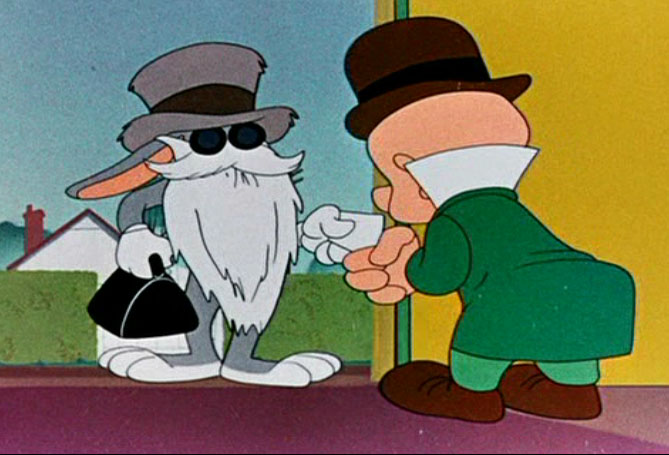- Hare Tonic
Infobox Hollywood cartoon
cartoon_name = Hare Tonic
series =Looney Tunes (Bugs Bunny ,Elmer Fudd )

caption =
director = Charles M. Jones
story_artist =Tedd Pierce
animator =Ken Harris
Basil Davidovich
Lloyd Vaughan
Ben Washam
voice_actor =Mel Blanc
Arthur Q. Bryan
musician =Carl W. Stalling
producer =Eddie Selzer
studio = Warner Bros. Cartoons
The Vitaphone Corporation
distributor =Warner Bros. Pictures
release_date =November 10 ,1945 (USA)
color_process =Technicolor
runtime = 7 min (one reel)
movie_language = English
imdb_id = 0037764"Hare Tonic" is a 1945
Warner Bros. cartoon in theLooney Tunes series, directed byChuck Jones , and it is also one of the last cartoonsTedd Pierce writes for Jones for almost another ten full years. It starsBugs Bunny andElmer Fudd . Voice characterizations are byMel Blanc andArthur Q. Bryan , respectively.The title is a play on "hair tonic", a type of patent medicine, reinforced by Bugs' portrayal of a fake doctor at one point in the picture. A bottle of "hare tonic" would appear as a prop in a 1946 cartoon, "
The Big Snooze ".Plot
Elmer Fudd has purchased Bugs Bunny at a local grocery store (with a sign visible in the window offering a special on "
Fresh Hare ") and is taking him home to make a meal. As he bounces along, he sings the tune of "Shortnin'Bread ", substituting "Wabbit Stew". Bugs pops out of Elmer's basket, munching on acarrot that was in there with him, and asks, "Eh, whatcha got in the basket, doc?" Elmer replies, "I got me a wabbit! I'm gonna cook me a wabbit stew!" Bugs states his "love" of rabbit stew (though he is clearly a rabbit) and then begs to see Elmer's rabbit. When Elmer opens his basket and finds it empty (Bugs had quickly climbed out), Bugs pushes his nemesis into his own basket and then sings the tune Elmer had been singing — but then Elmer realizes he's been tricked, and so he re-reverses the switch. Foreshadowing pranks to come, Bugs tells the audience from inside the basket (à laRed Skelton 's "mean widdle kid"), "He don't know me vewy well, do he?" Once at home, Bugs easily secures his escape by distracting Elmer, tricking him into thinking the phone has rung. However, just as he's about to leave, he decides he'd rather stay and heckle his would-be devourer. Bugs effects a radio broadcast that warns of the dread disease "rabbititis", which is contracted from rabbits "sold within the last three days" and which causes people to see spots and have "delusions assuming the characteristics of rabbits", among other dubious symptoms. This frightens the gullible Elmer and he informs Bugs that he is free to leave. Bugs, however, points out a sign on the door that states that the house is "QUARANTINED DUE TO RABBITITIS" and that no one can enter or leave.Thus Bugs stays to torment Elmer, and many hijinks ensue, including Bugs posing as a doctor ("Dr. Killpatient", parodying
Dr. Kildare ), and pretending to be Elmer's reflection in the mirror (a scene inspired by the famous mirror scene in the Marx Brothers' film, "Duck Soup "). Finally, Elmer sees Bugs' game and chases him out of the house with a shotgun. But Bugs quickly halts the chase and, in an unusually lengthy breaking of thefourth wall , even by Bugs' standards, he convinces Elmer that members of the audience are now afflicted with rabbititis, which causes Elmer to flee back into his house in terror.Bugs then addresses the audience and says the whole thing was "just a gag, of course" and that if the audience "really" had rabbititis, they'd see swirling red and yellow spots, whereupon red and yellow spots are seen swirling on the screen, and the underscore starts to build dramatically. Immediately after Bugs says, "Then everything'd go black!" the screen "does" go black, and the music stops abruptly and dramatically, followed by a second or two of dark silence. Bugs snickers and the cartoon ends. Bugs reappears from inside of the Looney Tunes drum (instead ofPorky Pig ), as he sometimes does at the end of "Looney Tunes", munching a carrot and saying, "And dat's de end!" rather than the usual "That's All Folks!" of Warner cartoons (see illustration).Notes
*This cartoon marks one of the few times Bugs addresses Elmer by name, albeit in the guise of "Dr. Killpatient", who addresses him as "Mr. Fudd". Despite their frequent cinematic encounters, many of their cartoons are played as if they had never met before.
Wikimedia Foundation. 2010.
